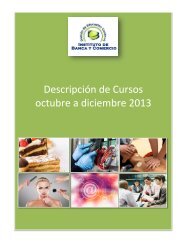cata espa revision 06252010 [todo] - Instituto de Banca y Comercio
cata espa revision 06252010 [todo] - Instituto de Banca y Comercio
cata espa revision 06252010 [todo] - Instituto de Banca y Comercio
You also want an ePaper? Increase the reach of your titles
YUMPU automatically turns print PDFs into web optimized ePapers that Google loves.
ight of first sale, the TEACH Act, fair use, the library exception, the right to make archival copies,among others.COPYRIGHT PROTECTED:Copyright" protects the original content of an authored work for a limited time as <strong>de</strong>fined by theCopyright Act. The "authored work" must be "fixed" in a physical medium in which the content is eitherreadily perceived or may be perceived with the aid of a machine or other <strong>de</strong>vice. Because the copyrightsubsists regardless of the nature of the physical medium, it is an intangible right and hence a type ofintellectual property right.Generally, the reproduction, preparation of a <strong>de</strong>rivative work, distribution, public display, and/or publicperformance of an authored work is the exclusive province of the copyright owner. However, thecopyright owner may license one or more of these rights to another third party.Copyright law does not protect i<strong>de</strong>as, procedures, principles, methods of operation, or facts,although compilations containing this information may be protected. In other words, the entirecontent of an authored work is not generally protected word-for-word, but to the extent that itcontains original expression, it is this original content which is protected. One notable exceptionto this, however, is that works of the United States (i.e., the fe<strong>de</strong>ral government or otherinstrumentality of the United States) are generally not protected by copyright.TEACH ActThe "TEACH" Act is also referred to the Technology, Education, and Copyright Harmonization Act of2002. It provi<strong>de</strong>s a copyright exemption whereby an instructor or a stu<strong>de</strong>nt may display or performlegally acquired (or legally ma<strong>de</strong>) copyrighted material in face-to-face teaching or distance learning solong as it is directly relevant to the course without needing permission from the copyright owner so longas the copyrighted material has been ma<strong>de</strong> by, at the direction of, or un<strong>de</strong>r the actual supervision of aninstructor. A notice should be provi<strong>de</strong>d which states that the material may be subject to copyrightprotection.For face-to-face teaching, virtually any kind of copyrighted work may be displayed or performed so longas it is relevant to the course topic.FACULTYIf a faculty member or instructor wants to show or play during a class certain relevant copyrighted worksuch as a movie, music clips, or show images of artworks, no copyright permission is necessary nor is anylicensing fee required in the context of a face-to-face teaching activity in a traditional classroom setting.However, this exception does not cover copyrighted works that are <strong>de</strong>signed or otherwise marketed fordistance learning and/or for textbooks, workbooks, aca<strong>de</strong>mic course packs, and other materials thatstu<strong>de</strong>nts generally purchase for class.Further, this exception also does not cover any material which the instructor wants stu<strong>de</strong>nts to study, read,listen, or watch on their own time outsi<strong>de</strong> of class.Accordingly, unless such an exception such as the "face-to-face teaching" exception (i.e., TEACH Act) orfair use applies or unless the work is not covered by copyright (e.g., expired copyright, work <strong>de</strong>dicated tothe public domain, etc.), one must obtain copyright permission to use the work (including reproduce,distribute, make a <strong>de</strong>rivative work, publicly perform, and/or publicly display).- 58 -


![cata espa revision 06252010 [todo] - Instituto de Banca y Comercio](https://img.yumpu.com/41236273/58/500x640/cata-espa-revision-06252010-todo-instituto-de-banca-y-comercio.jpg)
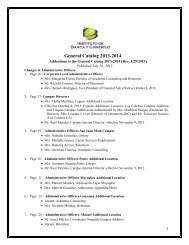
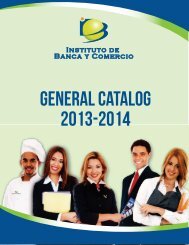
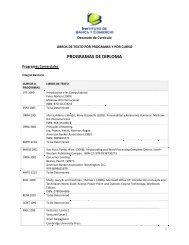
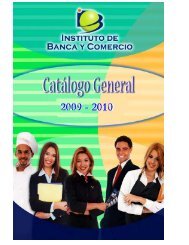
![CATA ING REV 8/08 [LARGO] - Instituto de Banca y Comercio](https://img.yumpu.com/44199430/1/190x245/cata-ing-rev-8-08-largo-instituto-de-banca-y-comercio.jpg?quality=85)
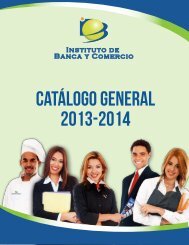
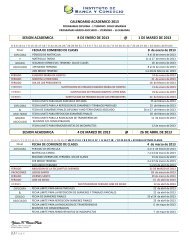

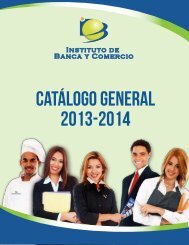
![CATA ING REV 8/08 [LARGO] - Instituto de Banca y Comercio](https://img.yumpu.com/40577524/1/190x245/cata-ing-rev-8-08-largo-instituto-de-banca-y-comercio.jpg?quality=85)
![cata espa revision 06252010 [todo] - Instituto de Banca y Comercio](https://img.yumpu.com/38349063/1/190x245/cata-espa-revision-06252010-todo-instituto-de-banca-y-comercio.jpg?quality=85)
![cata espa revision 06252010 [todo] - Instituto de Banca y Comercio](https://img.yumpu.com/38348971/1/190x245/cata-espa-revision-06252010-todo-instituto-de-banca-y-comercio.jpg?quality=85)

